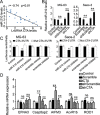Long non-coding RNA CTA sensitizes osteosarcoma cells to doxorubicin through inhibition of autophagy
- PMID: 28415557
- PMCID: PMC5458222
- DOI: 10.18632/oncotarget.16356
Long non-coding RNA CTA sensitizes osteosarcoma cells to doxorubicin through inhibition of autophagy
Abstract
Recently, several long non-coding RNAs (lncRNAs) have been implicated in osteosarcoma (OS). However, the regulatory roles of lncRNAs in chemotherapy resistance of OS still remain unclear. This study aimed to screen a novel lncRNA that contributes to chemotherapeutic resistance of OS, and to explore the underlying mechanisms. Our data showed that lncRNA CTA was markedly downregulated in OS tissues compared to their matched non-tumor tissues, and low expression of lncRNA CTA was significantly associated with the advanced clinical stage and tumor size. In addition, OS patients with low lncRNA CTA levels showed a worse prognosis when compared with those with high expression of lncRNA CTA. Furthermore, we report that lncRNA CTA has an inverse relationship with miR-210 expression in OS tissues. LncRNA CTA could be activated by doxorubicin (DOX), and could promote OS cell apoptosis by competitively binding miR-210, while inhibit cell autophagy. On the other hand, lncRNA CTA was downregulated in DOX-resistant OS cells. Overexpression of lncRNA CTA reduced autophagy and subsequently overcame DOX resistance of OS in vitro and in vivo. Therefore, we demonstrate that lncRNA CTA is an essential regulator in DOX-induced OS cell apoptosis, and the lncRNA CTA-miR-210 axis plays an important role in reducing OS chemoresistance.
Keywords: autophagy; doxorubicin; long non-coding RNA; osteosarcoma; resistance.
Conflict of interest statement
No conflicts of interest exits in this study.
Figures







Similar articles
-
LncRNA Sox2OT-V7 promotes doxorubicin-induced autophagy and chemoresistance in osteosarcoma via tumor-suppressive miR-142/miR-22.Aging (Albany NY). 2020 Apr 16;12(8):6644-6666. doi: 10.18632/aging.103004. Epub 2020 Apr 16. Aging (Albany NY). 2020. PMID: 32302291 Free PMC article.
-
A long non-coding RNA contributes to doxorubicin resistance of osteosarcoma.Tumour Biol. 2016 Feb;37(2):2737-48. doi: 10.1007/s13277-015-4130-7. Epub 2015 Sep 25. Tumour Biol. 2016. PMID: 26408180
-
Long noncoding RNA expression profiles of the doxorubicin-resistant human osteosarcoma cell line MG63/DXR and its parental cell line MG63 as ascertained by microarray analysis.Int J Clin Exp Pathol. 2015 Aug 1;8(8):8754-73. eCollection 2015. Int J Clin Exp Pathol. 2015. PMID: 26464619 Free PMC article.
-
Long non-coding RNAs in osteosarcoma.Oncotarget. 2017 Mar 21;8(12):20462-20475. doi: 10.18632/oncotarget.14726. Oncotarget. 2017. PMID: 28103585 Free PMC article. Review.
-
Potential regulatory role of lncRNA-miRNA-mRNA axis in osteosarcoma.Biomed Pharmacother. 2020 Jan;121:109627. doi: 10.1016/j.biopha.2019.109627. Epub 2019 Nov 20. Biomed Pharmacother. 2020. PMID: 31810120 Review.
Cited by
-
LncRNAs as potential prognosis/diagnosis markers and factors driving drug resistance of osteosarcoma, a review.Front Endocrinol (Lausanne). 2024 Jul 2;15:1415722. doi: 10.3389/fendo.2024.1415722. eCollection 2024. Front Endocrinol (Lausanne). 2024. PMID: 39015175 Free PMC article. Review.
-
H1Innovative approaches to combat anti-cancer drug resistance: Targeting lncRNA and autophagy.Clin Transl Med. 2023 Oct;13(10):e1445. doi: 10.1002/ctm2.1445. Clin Transl Med. 2023. PMID: 37837401 Free PMC article. Review.
-
Apatinib inhibits cell proliferation and migration of osteosarcoma via activating LINC00261/miR-620/PTEN axis.Cell Cycle. 2021 Sep;20(18):1785-1798. doi: 10.1080/15384101.2021.1949132. Epub 2021 Aug 23. Cell Cycle. 2021. PMID: 34424120 Free PMC article.
-
Regulation of immune-mediated chemoresistance in cancer by lncRNAs: an in-depth review of signaling pathways.Naunyn Schmiedebergs Arch Pharmacol. 2025 Apr 9. doi: 10.1007/s00210-025-04081-3. Online ahead of print. Naunyn Schmiedebergs Arch Pharmacol. 2025. PMID: 40202675 Review.
-
Targeting Autophagy Using Long Non-Coding RNAs (LncRNAs): New Landscapes in the Arena of Cancer Therapeutics.Cells. 2023 Mar 6;12(5):810. doi: 10.3390/cells12050810. Cells. 2023. PMID: 36899946 Free PMC article. Review.
References
-
- Hattinger CM, Fanelli M, Tavanti E, Vella S, Ferrari S, Picci P, Serra M. Advances in emerging drugs for osteosarcoma. Expert Opin Emerg Drugs. 2015;20:495–514. - PubMed
-
- Chang L, Shrestha S, LaChaud G, Scott MA, James AW. Review of microRNA in osteosarcoma and chondrosarcoma. Med Oncol. 2015;32:613. - PubMed
MeSH terms
Substances
LinkOut - more resources
Full Text Sources
Other Literature Sources

